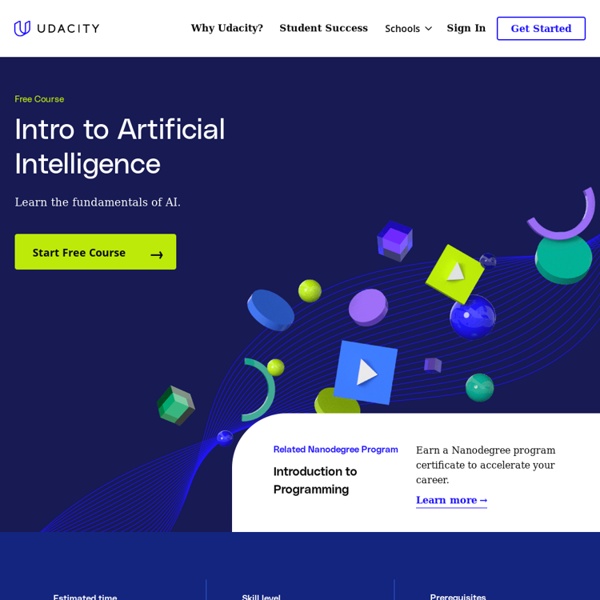



https://www.udacity.com/course/intro-to-artificial-intelligence--cs271
So You Want to Become a Biomedical Engineer Course Syllabus LESSON 1: Introduction Overview Course Structure Web Development Online Course Lesson 1: How the Web Works (2.5 hours) In this first lesson, you will learn basic concepts regarding the internet, browsers, HTML, and how all those elements fit together. You’ll start using HTML (HyperText Markup Language) to format content for webpages. Software Development Process This class is offered as CS6300 at Georgia Tech where it is a part of the Online Masters Degree (OMS). Taking this course here will not earn credit towards the OMS degree. In SDP, you will learn how to select and implement the ideal software process for your development project. Through Professor Orso's engaging examples and interviews with industry insiders, you will learn both conceptual and practical aspects of software engineering. The course covers requirements engineering, architecture and design, testing and maintenance, and software quality in general. The goal of this class is to equip you with the skills necessary to define requirements, set up an integrated development environment (IDE), learn Git (and Github!)
IIHT International The rate at which we are able to create data is rapidly accelerating. This ranges from biomedical data to social media activity and climate monitoring to retail transactions. These enormous quantities of data hold the keys to success across many domains from business and marketing to treating cancer or mitigating climate change. “According to IBM, globally, we currently produce over 2.5 Quintilian bytes of data a day.” The pace at which we produce data is rapidly outstripping our ability to analyse and use it. Science and industry are crying out for a new generation of data scientists who combine the statistical skills of data analysis and the computational skills needed to Carry out this analysis on a vast scale.
Artificial Intelligence Skip the MicroMasters Program Main Overview A series of credit-eligible courses recognized by industry. Gain expertise in one of the most fascinating and fastest growing areas of computer science through an innovative online program that covers fascinating and compelling topics in the field of Artificial Intelligence and its applications. Learn Responsive Images Lesson 1 - Getting up and Running Before you start working with responsive images, you need to start debugging on your mobile devices. This lesson will help you get started with Developer Tools and mobile debugging. Lesson 2 - Units, Formats, Environments You can't optimize what you can't measure.
Educational Technology A learning goal is what you should know by the end of the class. The broad learning goal for this class is that, by the end of the class, you will have the requisite knowledge to make a real contribution to the Educational Technology field. Even established experts in the field do not know everything, however, and neither will you. Instead, by the end of this class, you will have sufficient knowledge to contribute to the field in some way, though not every way. This means the learning goal of the class is determined in part by your own goals in taking this class: Are you interested in understanding how technology can help education more theoretically? Page 126 Strategic Communication Management Summit 2010 October 5–7, Waterview Conference Center, Washington DC A new city, a new format and a new focus for internal communicators.
Learning From Data (Introductory Machine Learning) This introductory computer science course in machine learning will cover basic theory, algorithms, and applications. Machine learning is a key technology in Big Data, and in many financial, medical, commercial, and scientific applications. It enables computational systems to automatically learn how to perform a desired task based on information extracted from the data. Machine learning has become one of the hottest fields of study today and the demand for jobs is only expected to increase. App Monetization Lesson 1: Introducing Monetization Developing an appropriate monetization strategy is comparable to finding the product/market fit for a new idea. This lesson will get you started on the path to finding that strategy by helping you think about profitability from the very beginning. You will also learn about different monetization models, profit margins, KPIs, and customer acquisition and retention.
Website Performance Optimization Testing Course Overview Throughout the course, you’ll build a performance toolbox to help you build faster website experiences by taking advantage of PageSpeed Insights recommendations and measuring page performance on mobile and desktop with Chrome Developer Tools. This class contains an introductory lesson, two primary lessons and a final project. Before diving into optimizations, you’ll build an understanding of how browsers convert HTML, CSS and JavaScript into websites.